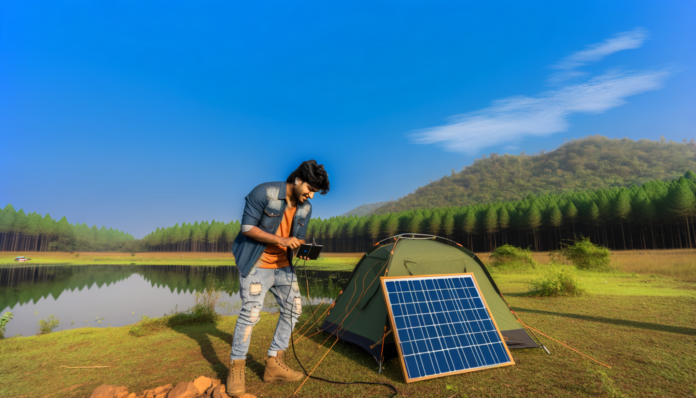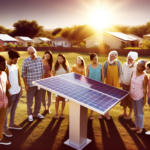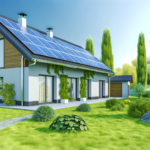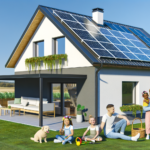Introduction to Solar Power for Adventurers
Why Solar Power?
In an era where sustainability is more important than ever, solar power stands out as a clean, renewable energy source that can significantly reduce your carbon footprint. For adventurers, the appeal of solar power lies in its ability to provide a reliable energy source in remote locations. Whether you’re deep in the wilderness or sailing across the ocean, solar power ensures you have the energy you need without relying on traditional fuel sources.
Benefits of Solar Power for Outdoor Enthusiasts
Solar power offers numerous advantages for those who love the great outdoors:
- Eco-Friendly: Solar energy is a green alternative to fossil fuels, producing no harmful emissions.
- Cost-Effective: After the initial investment, solar power is free, reducing the need for expensive fuel and batteries.
- Reliability: With advancements in solar technology, modern solar panels are highly efficient and can generate power even on cloudy days.
- Portability: Portable solar panels and chargers are lightweight and easy to carry, making them perfect for camping, hiking, and other outdoor activities.
- Independence: Solar power allows you to be self-sufficient, providing energy wherever you go without the need for electrical outlets.
Understanding Solar Energy Basics
Before diving into the specifics of solar power systems, it’s essential to understand the basics of how solar energy works. Solar panels, also known as photovoltaic (PV) panels, convert sunlight into electricity. This process involves several key components:
- Solar Cells: These are the building blocks of solar panels, made from semiconductor materials like silicon. When sunlight hits the cells, it excites electrons, creating an electric current.
- Inverter: This device converts the direct current (DC) produced by the solar cells into alternating current (AC), which is the type of electricity used by most appliances.
- Battery Storage: For adventurers, having a battery to store excess energy is crucial. This ensures you have power even when the sun isn’t shining.
- Charge Controller: This component regulates the voltage and current coming from the solar panels to prevent overcharging the battery.
By understanding these basics, you can better appreciate the technology behind solar power and make informed decisions about the best system for your needs. Whether you’re a seasoned adventurer or a weekend warrior, solar power can enhance your outdoor experiences while helping to protect the environment.
Choosing the Right Solar Power System
Types of Solar Power Systems
When it comes to solar power systems, there are several types to consider, each with its own set of advantages and applications. The most common types include:
- Monocrystalline Solar Panels: Known for their high efficiency and sleek design, these panels are made from a single crystal structure. They are ideal for those who need maximum power output in a limited space.
- Polycrystalline Solar Panels: These panels are made from multiple silicon crystals and are generally less expensive than monocrystalline panels. They offer a good balance between cost and efficiency.
- Thin-Film Solar Panels: Lightweight and flexible, thin-film panels are perfect for portable applications. However, they are less efficient compared to crystalline panels.
- Portable Solar Chargers: Designed for on-the-go use, these compact systems are perfect for charging small devices like smartphones and cameras during outdoor adventures.
Factors to Consider When Choosing a System
Selecting the right solar power system involves evaluating several key factors:
- Power Needs: Determine the total wattage required to power your devices and appliances. This will help you choose a system with adequate capacity.
- Budget: Solar power systems can vary significantly in cost. Consider your budget and look for a system that offers the best value for your money.
- Space Availability: Assess the amount of space you have for installing solar panels. This is particularly important for those with limited roof or ground space.
- Portability: If you plan to move your solar power system frequently, opt for portable solutions that are easy to set up and dismantle.
- Durability: Look for systems that are built to withstand harsh outdoor conditions, especially if you plan to use them in rugged environments.
Portable vs. Permanent Solutions
Choosing between portable and permanent solar power solutions depends on your specific needs and lifestyle:
- Portable Solutions: Ideal for adventurers who are always on the move, portable solar power systems are lightweight, easy to transport, and quick to set up. They are perfect for camping, hiking, and other outdoor activities where mobility is crucial. Examples include foldable solar panels and solar backpacks.
- Permanent Solutions: These systems are designed for long-term use and are typically installed on rooftops or mounted on the ground. They are suitable for cabins, RVs, and off-grid homes where a stable and continuous power supply is needed. Permanent solutions often offer higher power output and efficiency compared to portable options.
In summary, choosing the right solar power system involves understanding the different types available, evaluating your specific needs, and deciding between portable and permanent solutions. By considering these factors, you can select a system that best fits your eco-conscious lifestyle and outdoor adventures.
Setting Up Your Solar Power System
Essential Components
Setting up a solar power system for your outdoor adventures requires a few key components. Here’s a breakdown of what you’ll need:
- Solar Panels: These capture sunlight and convert it into electricity. Choose panels that are durable and suitable for your specific needs.
- Charge Controller: This device regulates the voltage and current coming from the solar panels to the battery, preventing overcharging.
- Battery: Stores the energy generated by the solar panels for use when sunlight is not available. Opt for deep-cycle batteries for better performance.
- Inverter: Converts the stored DC power in the battery to AC power, which is used by most appliances.
- Mounting Hardware: Necessary for securing the solar panels in place, whether on a vehicle, tent, or portable stand.
- Cables and Connectors: Ensure you have the right cables and connectors to link all components efficiently.
Step-by-Step Installation Guide
Setting up your solar power system can be straightforward if you follow these steps:
- Choose the Location: Select a spot with maximum sun exposure. For portable setups, ensure the area is free from obstructions like trees or buildings.
- Install the Mounting Hardware: Secure the mounting brackets or stands in place. Ensure they are stable and can withstand outdoor conditions.
- Attach the Solar Panels: Mount the solar panels onto the hardware. Make sure they are angled correctly to capture the most sunlight.
- Connect the Charge Controller: Link the solar panels to the charge controller using appropriate cables. This device will manage the flow of electricity to the battery.
- Install the Battery: Place the battery in a secure, ventilated area. Connect it to the charge controller, ensuring the polarity is correct.
- Set Up the Inverter: Connect the inverter to the battery. This will allow you to use AC-powered devices with your solar setup.
- Test the System: Once everything is connected, test the system to ensure it’s working correctly. Check the charge controller and inverter for any error messages.
Safety Tips and Best Practices
Safety is paramount when setting up and using a solar power system. Here are some tips to keep in mind:
- Read the Manuals: Always read the instruction manuals for each component. Follow the manufacturer’s guidelines for installation and use.
- Use Proper Tools: Ensure you have the right tools for installation. Using improper tools can damage components and pose safety risks.
- Check Connections: Regularly inspect all connections for wear and tear. Loose or damaged connections can lead to inefficiencies or hazards.
- Protect from Weather: While many components are weather-resistant, it’s best to provide additional protection from extreme conditions when possible.
- Monitor Battery Health: Keep an eye on your battery’s health. Overcharging or deep discharging can reduce its lifespan.
- Stay Informed: Stay updated on best practices and safety tips by joining online forums or communities dedicated to solar power enthusiasts.
By following these guidelines, you can set up a reliable and efficient solar power system to enhance your outdoor adventures while staying eco-conscious.
Maximizing Efficiency and Performance
Optimal Placement and Angle
To get the most out of your solar power system, it’s crucial to place your solar panels in an optimal location and at the right angle. **Placement** is key; ensure your panels are positioned where they will receive the most sunlight throughout the day. Avoid areas that are frequently shaded by trees, buildings, or other obstructions.
The **angle** of your solar panels also plays a significant role in their efficiency. Ideally, the panels should be tilted at an angle equal to your latitude to maximize exposure to the sun. For portable setups, adjustable mounts can help you change the angle as needed, depending on the time of year and your location. In general, a steeper angle is better for winter months, while a flatter angle is more effective during summer.
Maintaining Your Solar Panels
Regular maintenance is essential to keep your solar panels operating at peak efficiency. Here are some key maintenance tasks:
- Cleaning: Dust, dirt, and debris can accumulate on the surface of your panels, reducing their efficiency. Clean your panels with a soft brush or cloth and water. Avoid using abrasive materials or harsh chemicals.
- Inspection: Regularly inspect your panels for any signs of damage, such as cracks or corrosion. Check the wiring and connections to ensure they are secure and free from wear and tear.
- Monitoring: Keep an eye on your system’s performance. Many solar power systems come with monitoring tools that allow you to track energy production and identify any issues early on.
Monitoring and Troubleshooting
Effective monitoring and troubleshooting can help you maintain the efficiency and longevity of your solar power system. Here are some tips:
- Use Monitoring Tools: Many modern solar power systems come with built-in monitoring tools or apps that provide real-time data on energy production and system performance. Utilize these tools to keep track of your system’s output and identify any irregularities.
- Identify Common Issues: Be aware of common problems such as power loss, inadequate charging, and hot spots. Regularly check for these issues and address them promptly. For example, if you notice a significant drop in energy production, it could be due to shading, dirt accumulation, or a malfunctioning component.
- Troubleshooting Steps: If you encounter a problem, start by checking the most obvious causes. Ensure that all connections are secure, the panels are clean, and there are no obstructions blocking sunlight. If the issue persists, consult your system’s manual or seek professional assistance.
By following these guidelines for optimal placement, regular maintenance, and effective monitoring, you can ensure that your solar power system operates efficiently and reliably, providing you with clean energy for all your outdoor adventures.
Solar Power for Different Outdoor Activities
Camping
Camping and overlanding promise exhilarating adventures, but let’s admit it—nobody relishes the idea of being stranded in the dark with a flat battery. While there are a few options to generate power, some have drawbacks. Running your engine to charge the battery might burn fuel and disrupt the tranquility with its noise. Hauling a gas-powered generator occupies space, demands additional fuel, and adds an intrusive buzz to the natural serenity—hardly ideal. Enter solar power, the ultimate savior! Boasting a plethora of benefits, solar power emerges as the definitive remedy for introducing illumination, energy, and environmental friendliness to your outdoor escapades.
**Portable Solar Panels:** Lightweight and easy to carry, these panels can be set up anywhere to soak up the sun’s rays. Simply unfold, position towards the sun, and let the power flow. They’re a game-changer for recharging your devices, running lights, or even powering your trusty coffee maker.
**Solar-Powered Generators:** These portable powerhouses store the sun’s energy in a battery, ready to supply you with electricity whenever you need it. From charging multiple devices to running a mini fridge for those refreshing beverages, solar-powered generators have got your back.
**Solar Chargers for Devices:** These nifty devices use the sun’s power to charge your gadgets on the go. Whether you’re capturing breathtaking landscapes or staying connected with loved ones, solar chargers ensure you never miss a moment or a Facebook update.
Hiking
For hikers, the need for lightweight and efficient power solutions is paramount. Solar power offers a reliable and eco-friendly way to keep your essential devices charged without adding significant weight to your pack.
**Portable Solar Chargers:** Compact and lightweight, these chargers can be attached to your backpack, allowing you to charge your devices as you hike. They are perfect for keeping your GPS, smartphone, or camera powered up throughout your journey.
**Solar-Powered Headlamps and Lanterns:** These are essential for night hikes or setting up camp after dark. They provide reliable lighting without the need for disposable batteries, making them an eco-friendly choice.
**Solar-Powered Water Purifiers:** Some advanced water purifiers now come with solar charging capabilities, ensuring you have access to clean drinking water even in the most remote locations.
Boating
Boating enthusiasts can greatly benefit from solar power, as it provides a sustainable way to keep essential systems running without relying on shore power or noisy generators.
**Solar Panels for Boats:** These can be mounted on the deck or other flat surfaces to capture sunlight throughout the day. They can power navigation systems, lights, and other essential equipment, ensuring a smooth and safe journey.
**Solar-Powered Bilge Pumps:** These pumps can help keep your boat dry by automatically removing water that accumulates in the bilge, powered entirely by solar energy.
**Solar-Powered Refrigerators:** Keep your food and drinks cool without draining your boat’s battery. Solar-powered refrigerators are efficient and can run continuously as long as there is sunlight.
Living Off-Grid
For those who choose to live off-grid, solar power is not just a convenience but a necessity. It provides a reliable and sustainable source of energy that can power an entire household.
**Solar Panel Arrays:** A well-designed solar panel array can generate enough electricity to power all your household needs, from lighting and heating to running appliances and charging devices.
**Solar Batteries:** These are essential for storing the energy generated during the day for use at night or during cloudy periods. Modern lithium-ion batteries are efficient and have a long lifespan, making them ideal for off-grid living.
**Solar Water Heaters:** These systems use solar energy to heat water for household use, reducing the need for gas or electric water heaters and lowering your overall energy consumption.
**Solar-Powered Appliances:** From refrigerators and washing machines to fans and air conditioners, many household appliances now come with solar power options, making it easier to maintain a comfortable lifestyle while living off-grid.
By integrating solar power into your outdoor activities, you not only enhance your experience but also contribute to a more sustainable and eco-friendly way of living. Whether you’re camping, hiking, boating, or living off-grid, solar power offers a versatile and reliable solution to meet your energy needs.
Innovative Solar Technologies and Trends
Latest Innovations in Solar Power
The field of solar power is constantly evolving, with new technologies emerging to make solar energy more efficient, accessible, and versatile. One of the most exciting innovations is the development of *perovskite solar cells*. These cells promise higher efficiency rates and lower production costs compared to traditional silicon-based cells. Additionally, *bifacial solar panels*, which can capture sunlight from both sides, are gaining popularity for their ability to generate more power from the same surface area.
Another groundbreaking innovation is the advent of *solar skins*. These are custom-designed overlays that can be applied to solar panels to make them blend seamlessly with the aesthetics of a building or vehicle. This technology is particularly appealing for those who want to maintain the visual appeal of their property while harnessing solar energy.
Emerging Trends in Renewable Energy
As the world shifts towards more sustainable energy solutions, several trends are emerging in the renewable energy sector. One significant trend is the integration of *solar power with energy storage systems*. Combining solar panels with batteries allows for the storage of excess energy generated during the day, which can then be used during nighttime or cloudy days. This not only maximizes the use of solar power but also enhances energy reliability and independence.
Another trend is the rise of *community solar projects*. These initiatives allow multiple households or businesses to share the benefits of a single solar power system, making solar energy more accessible to those who may not have the means to install their own panels. Community solar projects are particularly beneficial in urban areas where space for individual solar installations is limited.
Future Prospects for Solar Power
The future of solar power looks incredibly promising, with ongoing research and development paving the way for even more advanced technologies. One area of focus is the improvement of *solar panel efficiency*. Researchers are exploring new materials and designs to create panels that can convert a higher percentage of sunlight into electricity. This could significantly reduce the cost of solar energy and make it a more viable option for a broader range of applications.
Another exciting prospect is the potential for *solar-powered transportation*. From solar cars to solar-powered drones, the possibilities are vast. These innovations could revolutionize the way we think about transportation, reducing our reliance on fossil fuels and decreasing our carbon footprint.
In conclusion, the landscape of solar power is rapidly changing, driven by technological advancements and a growing commitment to sustainability. By staying informed about the latest innovations and trends, eco-conscious adventurers can make the most of solar energy and contribute to a greener future.
Conclusion and Additional Resources
Recap of Key Points
As we conclude our journey into the world of solar power for the eco-conscious adventurer, let’s recap the key points covered in this guide:
- Introduction to Solar Power: We explored the reasons why solar power is an excellent choice for outdoor enthusiasts, highlighting its benefits such as sustainability, cost savings, and independence from the grid.
- Choosing the Right System: We discussed various types of solar power systems, factors to consider when selecting a system, and the differences between portable and permanent solutions.
- Setting Up Your System: We provided a step-by-step guide to installing a solar power system, including essential components, installation tips, and safety practices.
- Maximizing Efficiency: We covered strategies for optimal placement and angle of solar panels, maintenance tips, and troubleshooting common issues.
- Solar Power for Activities: We examined how solar power can be utilized for different outdoor activities such as camping, hiking, boating, and living off-grid.
- Innovative Technologies: We looked at the latest innovations and emerging trends in solar power, as well as future prospects for this renewable energy source.
Further Reading and Resources
To deepen your understanding and stay updated on the latest developments in solar power, consider exploring the following resources:
- U.S. Department of Energy – Solar Energy Technologies Office: Comprehensive information on solar energy research, development, and deployment.
- Solar Power World: A leading online resource for solar power news, technology updates, and industry insights.
- National Renewable Energy Laboratory (NREL) – Solar Research: In-depth research and data on solar energy technologies and applications.
- Solar Power Bible for Off-the-Grid and Hybrid Living: A comprehensive guide for simplified solar power solutions for various living situations.
Community and Support Networks
Engaging with a community of like-minded individuals can provide valuable support and insights as you embark on your solar power journey. Here are some communities and support networks to consider:
- Online Forums: Websites like Solar Panel Talk and Reddit’s Solar Community offer platforms for discussing solar power topics, sharing experiences, and seeking advice.
- Local Solar Groups: Many regions have local solar energy groups or clubs that organize events, workshops, and meetups. Check with your local environmental organizations or community centers.
- Professional Associations: Organizations such as the Solar Energy Industries Association (SEIA) and the American Solar Energy Society (ASES) provide resources, networking opportunities, and advocacy for solar energy enthusiasts.
- Social Media: Follow solar power influencers and groups on platforms like Facebook, Instagram, and Twitter to stay informed and connected with the solar community.
By leveraging these resources and communities, you can continue to expand your knowledge, stay updated on the latest trends, and connect with others who share your passion for sustainable energy solutions. Embrace the power of the sun and enjoy the benefits of a greener, more eco-friendly lifestyle.






